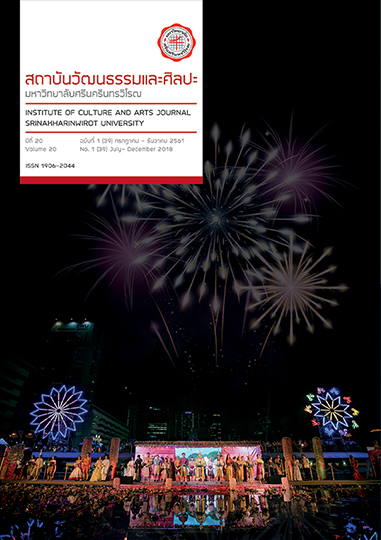A Study on Kin Kao Mai ritual and its Music of Karen people at Kong Mong Ta Village, Laiwo Sub-district, Sangklaburi District, Kanchanaburi Province
คำสำคัญ:
Kin Kao Mai, Karen music, Chapu cha-uบทคัดย่อ
The research “A Study on Kin Kao Mai ritual and its Music of Karen people at Kong Mong Ta Village, Laiwo Sub-district, Sangklaburi District, Kanchanaburi Province” is a descriptive analysis work using ethnomusicological method with the objectives 1) to study kin khao mai ritual, 2) to study the music performed in kin khao mai ritual and 3) to transcribe the music using Thai notation and Western notation system.
The result of the research revealed that kin khao mai, literally translated as “eating new rice”, was one of the most important rice-associated ritual of Karen people. Also known presently as New Rice Virtue tradition, kin kao mai ritual is held annually in Laiwo sub-district with the host rotated among the 6 villages within the sub-district vicinity. During January 21-22, 2016, Kong Mong Ta village held the ritual which included a merit making ceremony (tamboon) and marked new rice eating period for the Karen people in the sub-district. Also observed in the ritual were offering of new rice to the Lord Buddha and begging pardon from Pramae Phosop, the goddess of rice. This two-day ritual began with offering of food to Buddhist monks followed by Buddhist religious ritual in the morning, after which there were various kinds of entertainment activities including indigenous Karen dance and music. The second day, the kin khao mai day, started with offering of newly harvested rice and food followed by another Buddhist religious ritual. The highlight of the second day was after the Buddhist religious ritual when the villagers built pai sa wo, a booth-like structure on which ritualistic performances, such as honoring Phramae Phosop and sacred thread tying on participants’ wrists, were observed. Although there were as much variety of entertainment activities in the evening, but it appeared that indigenous Karen dance and music were more featured than it was in the previous night.
The ensemble performed in the ritual was called chapu cha-u, which mostly accompanied the dance. It consists of a mong wyn, a gee wyn, a patala, a taperw, a chakong, a set of pow, a wa leh kor jee and a jeng jee. Five traditional musical pieces were played during the two nights: Paw Ja (2 movements), Jojo A (1 movement), Wei Jo (3 movements), Latalaya (1 movements) and Terng-lee Tow Moola (15 phrases). All the pieces played were vocal music except Latalaya which was insrumental. Refrain section of each piece contained varying length and was played as an introduction, a bridge between two movements or repetitions, and an ending. Vocal part was absent on the refrain in all vocal pieces.
The performed pieces were transcribed to Thai notation using Thai solfege as well as in Western music notation with 24 time signature. Determination of pitch register in the Western notation was based on the Thai notation transcriptions.
Downloads
เอกสารอ้างอิง
โกวิท แก้วสุวรรณ. ดูทุหล่า ในพิธีเรียกวีหล่าของชาวกะเหรี่ยงโป: กรณีศึกษากะเหรี่ยงโป บ้านเกาะสะเดิ่ง ต.ไล่โว่ อ.สังขละบุรี จ.กาญจนบุรี. วิทยานิพนธ์ศิลปศาสตรมหาบัณฑิต สาขาวัฒนธรรมศึกษา. บัณฑิตวิทยาลัย
มหาวิทยาลัยมหิดล. 2542.
_______ สะคู เพลงกะเหรี่ยงโปแห่งผืนป่าทุ่งใหญ่นเรศวร. วารสารอักษรศาสตร์ มหาวิทยาลัยศิลปากร. ปีที่ 22 ฉบับที่ 1. 2542.
_______ ทูรู่เหมยเบี่ยะ กิจกรรมจารีตประเพณีของกะเหรี่ยงโป ต.ไล่โว่ อ.สังขละบุรี จ.กาญจนบุรี. วารสารมหาวิทยาลัยศิลปากร. ปีที่ 19 – 20 ฉบับที่ 1. 2543.
ขวัญชีวัน ศรีสวัสดิ์. ขบวนการครูบาขาวปีกับกะเหรี่ยงโปว์ในภาคเหนือของประเทศไทย. งานวิจัย, ทุนสำนัก]คณะกรรมการวัฒนธรรมแห่งชาติ. 2532
งามพิศ สัตย์สงวน. การวิจัยทางมานุษยวิทยา (พิมพ์ครั้งที่ 4). จุฬาลงกรณ์มหาวิทยาลัย. กรุงเทพฯ. 2542.
จรัญ กาญจนประดิษฐ์. การศึกษาดนตรีชาวกะเหรี่ยง หมู่บ้านกองม่องทะ ตำบลไล่โว่ อำเภอสังขละบุรี จังหวัดกาญจนบุรี. ปริญญานิพนธ์ศิลปกรรมศาสตรมหาบัณฑิต มานุษยดุริยางควิทยา. กรุงเทพฯ. บัณฑิตวิทยาลัย
มหาวิทยาลัยศรีนครินทรวิโรฒ. 2547.
ณรงค์ชัย ปิฎกรัชต์, นิรันดร์ ภักดี และ เอกราช แพรม่วง. ดนตรีชนเผ่ากะเหรี่ยงสะกอในพื้นที่มู่เส่คี. กรุงเทพฯ, วิทยาลัยดุริยางคศิลป์ มหาวิทยาลัยมหิดล. 2542.
นิยพรรณ วรรณศิริ. มานุษยวิทยาสังคมและวัฒนธรรม. กรุงเทพฯ, มหาวิทยาลัยธรรมศาสตร์. 2540.
ประเวศ วะสี. วัฒนธรรมกับการพัฒนา. สำนักงานคณะกรรมการวัฒนธรรมแห่งชาติ, โรงพิมพ์คุรุสภา. 2538.
ปิ่นแก้ว เหลืองอร่ามศรี. พุทธะผีธรรมชาติและมนุษย์: จักรวาลวิทยาของคนกะเหรี่ยงในทุ่งใหญ่. เมืองโบราณ. ปีที่ 19. 2536.
_______ ภูมิปัญญานิเวศวิทยาชนพื้นเมือง: ศึกษากรณีชุมชนกะเหรี่ยงในป่าทุ่งใหญ่นเรศวร. นนทบุรี, สำนักพิมพ์ดุลยภาพ. 2539.
พิพัฒน์ เรืองนาม. ชาวกะเหรี่ยงและวัฒนธรรมของชาวกะเหรี่ยง ตำบลไล่โว่ อำเภอสังขละบุรี จังหวัดกาญจนบุรี ในสังคมและวัฒนธรรมกะเหรี่ยงกาญจนบุรี. นครปฐม, มหาวิทยาลัยศิลปากร พระราชวังสนามจันทร์. 2533.
มณฑล คลแถวทอง. ชาวไทยเชื้อสายกะเหรี่ยงในจังหวัดกาญจนบุรี, กาญจนบุรีศึกษา. ศูนย์ศิลปวัฒนธรรม สถาบันราชภัฏกาญจนบุรี. 2538.
ยศ สันตสมบัติ. มนุษย์กับวัฒนธรรม. กรุงเทพฯ, สำนักพิมพ์มหาวิทยาลัยธรรมศาสตร์. 2540.
วุฒิ บุญเลิศ. ความเชื่อของชาวกะเหรี่ยงเกี่ยวกับ “ผี บือ โย” (แม่โพสพ). เมืองโบราณ ปีที่ 19 (4) 11 – 20. 2536.
ศุทธินี ทรงสะอาด. ชาวเขาเผ่ากะเหรี่ยงในจังหวัดกาญจนบุรี, สังคมและวัฒนธรรมกะเหรี่ยง จังหวัดกาญจนบุรี. นครปฐม, มหาวิทยาลัยศิลปากร พระราชวังสนามจันทร์. 2533.
สุพัตรา สุภาพ. สังคมวิทยา. พิมพ์ครั้งที่ 13. กรุงเทพฯ, โรงพิมพ์ไทยวัฒนาพาณิช. 2540.
__________. สังคมและวัฒนธรรมไทย. กรุงเทพมหานคร: โรงพิมพ์ไทยวัฒนาพาณิช. 2536.
สุรพงษ์ กองจันทึก. ประเพณีผูกข้อมือ การกินน?้ำสุก และพุทธศาสนา: กรณีกระเหรี่ยงโป ภาคกลาง. 2530.
สุรินทร์ เหลือลมัย. ความเชื่อทางศาสนาของชาวกะเหรี่ยง: กรณีศึกษาวันปีใหม่กะเหรี่ยงที่วัดแจ้งเจริญ อ?ำเภอวัดเพรง
จังหวัดราชบุรี. งานวิจัยทุนคณะกรรมการวัฒนธรรมแห่งชาติ. 2538.
Tylor, E.B. Primitive Culture. Vol.1. 1871, Best, John W. Research in Education. 3rd ed. New Delhi: Prentice Hall of India Inc., 1978
ดาวน์โหลด
เผยแพร่แล้ว
รูปแบบการอ้างอิง
ฉบับ
ประเภทบทความ
สัญญาอนุญาต
บทความทุกบทความที่ได้รับการตีพิมพ์ถือเป็นลิขสิทธิ์ของวารสารสถาบันวัฒนธรรมและศิลปะ มหาวิทยาลัยศรีนครินทรวิโรฒ



